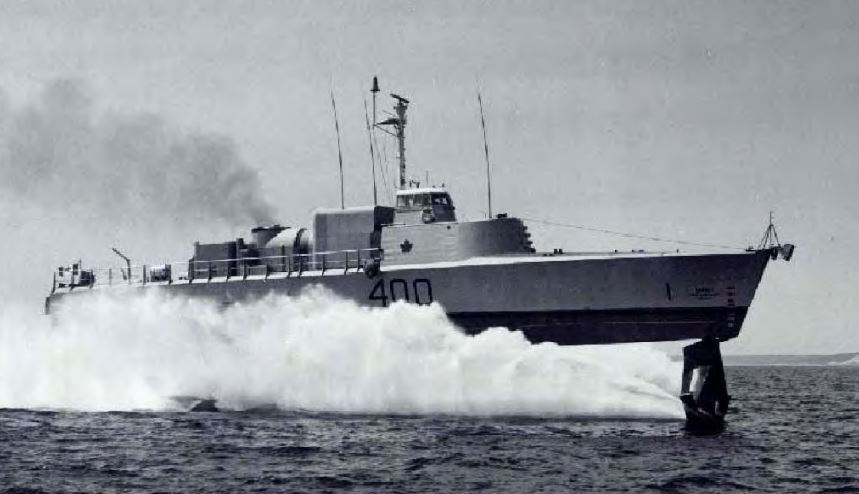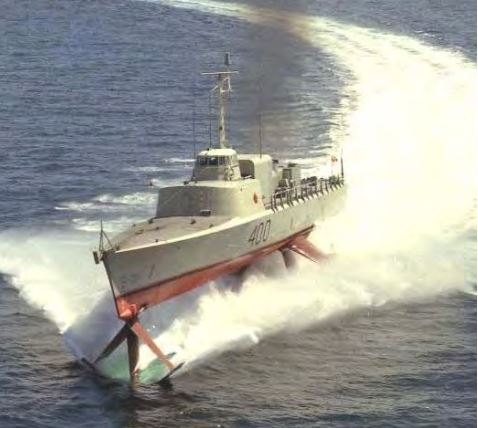By: Richard Crowder

Canada was the preeminent developer of the hydrofoil design before its latest revival by the boating industry
What is the first word that pops into your mind when I mention the name, Sir Alexander Graham Bell? The telephone of course. And yes, he was the first to patent what we would know as the telephone and eventually cofound the American Telephone and Telegraph Company (AT&T) and make the first “long distance” call between Brantford and Paris in Ontario.
He was born and university educated in Scotland then moved with his family to what is now the Bell Homestead, a farm near Brantford, Ontario as a British Subject. There he began teaching and experimentation with the deaf in Boston where he became a US Citizen. His favourite place to think and invent “out of the box” was at his summer home near Baddeck on Bras d’Or Lake in Cape Breton, Nova Scotia.
Bell was a genius inventor with patents ranging from the photophone, phonograph, the metal detector, the audiometer to detect hearing problems, a metal jacket to assist in breathing, a device to locate icebergs, a device to separate salt from sea water, a method that became the forerunner to magnetic tape recording and later hard and floppy discs, a primitive form of air conditioning, composting toilets, alternative fuels, solar panels for heating, as well as five patents related to airplanes and four related to “hydro airplanes.”

After reading an article in Scientific American, Bell started his own research into hydrofoils in the early 1900’s as a way to assist airplanes to take off from water. The biggest impediment to boat speed is the friction water has on the hull surface. If that boat could be “lifted” above the water by using foil technology, then boat speed could theoretically increase dramatically. Bell had already been experimenting with tetrahedral box kites as part of his obsession with heavier-than-air flying. That obsession had helped him form the Aerial Experiment Association with his assistant Frederick “Casey” Baldwin and a few others.
In 1909, shortly after the Wright Brothers’ historic flight, this group would be responsible for Canada’s first heavier-than-air powered flight of their "Silver Dart" design piloted by AEA member J.A.D. McCurdy. It took place on frozen Bras d’Or Lake in Nova Scotia. Baldwin and McCurdy would then set-up Canada’s first and most successful aircraft company, the Canadian Aerodrome Company. Bell’s knowledge of wing design and the principles of lift in airfoil design would prove to be invaluable to his interest in hydrofoils.
During World War I, Bell, utilizing research from others around the world while refining his own designs, built several experimental hydrofoil boats culminating in the HD-4. The boat was powered by Renault engines and attained an astounding top speed of 54 mph (87 kph). With more prototype development and with a pair of 350 hp engines secured through the US Navy, the updated HD-4 hydrofoil set an on-water speed record of 71 mph (114 kph) in 1919. This record held for 10 years.
Skip ahead to the end of WWII and the escalating Cold War between the East and the West. Canada had created the Defense Research Board (DRB) in 1947 and designed for military research to protect Canada both from the air but also along its massive coastal shoreline from the burgeoning Soviet submarine fleet. The DRB was instrumental in the development of the Distant Early Warning (DEW) radar line extending across Canada’s north, but they also needed a fast boat to locate and hunt enemy submarines.
In the early 1950’s, the DRB combined research with the British Admiralty and the British company Saunders-Roe to produce a small experimental hydrofoil dubbed the R-101 for the Royal Navy. DRB ordered one from Saunders-Roe, and after testing it off the coast of Wales, it arrived in Canada as the R-103 in 1957 for testing and evaluation by the Royal Canadian Navy. In recognition of Bell’s earlier work on hydrofoils, It was named the Bras d’Or.
An interesting note here to Canadian historians is that the R-103 was transported to Canada strapped to the flight deck of Canada’s only ever aircraft carrier, the HMCS Bonaventure, on its maiden trans-Atlantic crossing. Following the unification of Canada’s armed forces, Bonaventure was decommissioned in Halifax in 1970 and sold for scrap to Taiwan in 1971.
The R-103 was constructed of aluminum with a unique tapered-transom design. It was sixty feet long and powered by a pair of 1,500 horsepower Rolls-Royce Griffon gasoline engines mounted inline due to the tapered transom, and had a top speed of 35 mph (56 kph). It was eventually retired from the Navy when the hydrofoil program was cancelled in the early 1970’s and later acquired by the Canada Science and Technology Museum in Ottawa where it sits in storage with the foils removed.
A fascinating side-note to this is that A.V. Roe, who owned the Avro Aircraft Company, had taken over the Saunders company in 1929 and renamed it Saunders-Roe. Avro of course became famous as builders of the Lancaster bomber both in Britain and Canada during the war years and later the Avro delta-wing Vulcan bomber. When Roe first got involved, Saunders were primarily a boatbuilder but gradually morphed into flying boat aircraft during and following World War II.
As money for R&D for military purposes accelerated during the Cold War, the Avro Aircraft Company designed and built the Avro Arrow, recognized as the most advanced jet fighter plane in the world at the time. The Canadian government cancelled the Arrow project in early 1959 and Canada lost many top aeronautical minds to the newly formed NASA space program in the USA. Some also jumped to de Havilland Aircraft and contributed to the Bras d’Or hydrofoil design. At the same time, the Saunders-Roe Company in England became a world leader in hovercraft design.
Now back to hydrofoils. As part of a tri-lateral agreement on anti-submarine detection, instead of overlapping their efforts, Britain focused on hovercraft research, the United States on nuclear submarines, and, given its previous successes, Canada took on the role of surface-piercing hydrofoil research. As a result of this agreement and the success of R-103, in 1960 the Royal Canadian Navy (RCN) contracted with de Havilland Aircraft of Canada in Downsview, Ontario to design a full-size sub-chaser.
Marine Industries Limited of Sorel, Quebec subcontracted to De Havilland and in 1963, and the keel of the aluminum hulled hydrofoil was laid. Work was completed for the Royal Canadian Navy, and when it launched in 1968 it was commissioned the HMCS Bras d’Or by the newly unified Canadian Armed Forces after the reorganizing of the Royal Canadian Navy. The name given to this new vessel required that the original hydrofoil R-103 be renamed Baddeck, again in honour of Bell and his summer home town in Nova Scotia.
The FHE (Fast Hydrofoil Escort) 400 Bras d’Or, as its official name became under the new unified Forces, was 164 feet (50 m) long and powered in foil configuration by a Pratt & Whitney turbine developing 25,500 hp at 21,500 RPM. This delivered power through gearboxes to super cavitating propellers mounted at the bottom of the main load-supporting foils. When operating below foil speeds, a 2,400 hp, 16-cylinder high speed diesel engine powered a separate pair of variable pitch propellers mounted part way down the main foils.
There were no rudders per se for steering, but instead the entire diamond-shaped bow foil turned through both manual and automatic hydraulic actuators to steer the ship. Fine tuning was assisted by aileron-type actuators on the leading and trailing edges of some of the dihedral (upward sloping) and anhedral (downward sloping) foils on the bow and on the main load-bearing foils. There were both manual and automatic roll control actuators in the tips of the main foils. These two main load-bearing foils looked almost identical to a pair of aircraft wings.
Two additional but much smaller turbines provided electrical and emergency power for smaller applications like fire pumps. The crew consisted of 25 persons including 7 officers and what had to be a most experienced Captain with both a naval and aircraft background der to take a 240 ton ship 'airborne' above any normal hull speed for the type of vessel. Provisions were made in the original design for armaments on board, but the Bras d’Or was not armed during sea trials due to cost overruns during the building process.
In late 1968, Bras d’Or was delivered on a barge to the Halifax naval base where displacement-only sea trials were first performed. In the summer of 1969, full foil tests under full load conditions produced a top speed of just over 70 mph (120 kph) in 3-4 foot sea conditions. This was an unofficial speed record for a warship. The following year, it was tested successfully in 12 foot seas and proved the viability of hydrofoil design. Range was found to be close to 3000 km at hull speed and 1000 km at foil speeds.
During the development period submarine warfare had been proven to be best handled by nuclear submarines, and so Canada’s military priorities changed to sovereignty protection. For whatever reason, a fast ship didn’t seem to fit the criteria and the expensive hydrofoil testing program was cancelled in late 1971. The Bras d’Or was put on shore at the Halifax Naval Base.
It sat there for 5 years until the program was officially scrapped and the ship and its components were put up for sale by Crown Assets Disposal Corporation. The ship itself was saved and donated to the Musée Maritime du Quebec at L’Islet-sur-Mer, Quebec. You can still get a full tour of this amazing piece of Canadian ingenuity.
So, next time you spot the newest and flashiest hydrofoil pleasure boat in the media, think back to the Bras d’Or and how Canada led the way in advancing this technology. We may have lost all the finished examples of the Avro Arrow, but fortunately we saved the only example of Canada’s leadership in hydrofoil design, the HMCS Bras d’Or, named in honour of Sir Alexander Graham Bell’s extraordinarily inventive spirit.





















Canada actually had 4 carriers, although 2 were lend lease. HMCS Puncher, HMCS Warrior, and prior to HMCS Bonaventure was HMCS Magnificent, Great article!